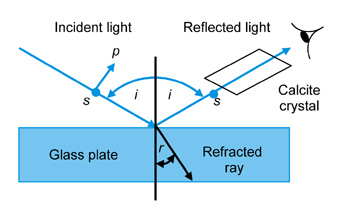Optipedia • SPIE Press books opened for your reference.
Brewster's Law
Excerpt from Field Guide to Polarization
Around 1812 Brewster discovered that for different glasses the p-polarized ray (in the plane of the paper) vanished completely at a particular angle of incidence i. Furthermore, by rotating the analyzing calcite crystal through 90°, the s-polarized ray (directed out of the plane of the paper) became extinguished. He then discovered that the refracted ray angle r was simply related to the incident ray angle i by


Snell’s law of refraction between the two media is

where n1 and n2 are the refractive indices of the media, respectively. For air n1 = 1 and for glass n2 = n. Substituting the first equation into Snell’s law leads to

This equation is known as Brewster’s law. Its immediate practical use was that it enabled the refractive index of glass to be determined by reflection rather than by refraction; the measurement of the refractive angle r by transmission is difficult. The result of this discovery was that it led to the rapid development and measurement of new optical glasses.
E. Collett, Field Guide to Polarization, SPIE Press, Bellingham, WA (2005).
View SPIE terms of use.

